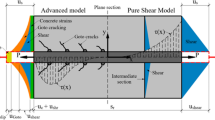Abstract
This paper describes a new model for predicting crack width in presence of different percentages of reinforcement and concrete strength classes that became from 30 to 80 MPa.
The theoretical analysis is used to interpret the results of experimental trials on reinforced concrete ties submitted to tensile forces without inducing any yield in the bar.
The purpose of the investigation was to study and predict the crack width using as base parameters the stress in the steel at crack and the mean distance between cracks. The calculation model is based also on a precise mechanical characterization of the concrete's effective tensile strength (i.e. in presence of reinforcement) and give a sufficiently user friendly procedure to determine crack width without taking into account the concrete and steel deformation, which are difficult to measure.
Résumé
Cet article présente un nouveau modèle de prévision de l'amplitude des fissures en présence de différents pourcentages d'armatures et de classe de résistance allant de 30 à 80 MPa.
L'analyse théorique est utilisée pour interpréter les résultats des essais expérimentaux sur des traverses en béton armé soumis à des forces de traction sans rein ajouter à la barre.
Le but de cette recherche était d'étudier et de prévoir la largeur des fissures, en utilisant comme paramètres de base la contrainte dans l'acier et la distance moyenne entre les fissures.
Le modèle de calcul est basé également sur une caractérisation mécanique précise de la résistance à la traction du béton, en présence d'armature, et donne une méthode facile pour déterminer l'amplitude des fissures sans prendre en compte la déformation de l'acier et du béton qui sont difficiles à mesurer.
Similar content being viewed by others
References
Jaccoud, J. P., Charif, H. and Farra, B. ‘Cracking behaviour of HSC structures and practical consequences for design’,EPFL Publ. n.139 (1993).
Noghabai, K., ‘Bond properties of high strength concrete’, High Strength Concrete'93, Norway (1993).
Gupta, A. K. and Maestrini, R., ‘Tension stiffening model for reinforced concrete bars’,Journal ASCE 117 (3) (March 1989).
Model Code ‘90, Bulletin d'Information n. 213/214, Thomas Telford Editor, May (1993).
Eurocode 2, ‘Design of concrete structures-Part 1-1: General rules and rules for buildings’, 1992-1-1, (1992).
Farra, B. and Jaccoud, J. P., ‘Rapport des essais de tirants sous déformation imposée de courte durée’, IBAP, Publication n.140, Novembre (1993).
Rehm, G., ‘On the basic behavior of bond between steel and concrete’ (Only available in German), Deutscher Ausschuß für Stahlbeton, Heft 138, Verlag W. Ernst & Sohn, Berlin, (1961).
Beeby, A. W., ‘A study of cracking in reinforced concrete members subjected to pure tension’, Cement and Concrete Association, 42.468 June (1972)
Bigay, A. J., ‘Bond behaviour of deformed bars in NSC and HSC’, TU Delft September, Report 25.5-95-II, (1995).
Creazza, G., Di Marco, R., Russo, S. and Siviero, W., ‘Tension Stiffening in High Strength Concrete’, Fourth Int. Sym. on the ‘Utilization of High Strength/High Performance Concrete’, 29–31 May, Paris, (1996).
Author information
Authors and Affiliations
Additional information
Editorial note Prof. G. Creazza is a Rilem Senoir Member.
Rights and permissions
About this article
Cite this article
Creazza, G., Russo, S. A new model for predicting crack width with different percentages of reinforcement and concrete strength classes. Mat. Struct. 32, 520–524 (1999). https://doi.org/10.1007/BF02481636
Received:
Accepted:
Issue Date:
DOI: https://doi.org/10.1007/BF02481636




